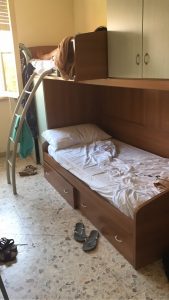Costs of Study Abroad? Not as much as you imagine
I’m studying abroad for two semesters. The thought of that alone might make people (including me, to be quite honest) shudder for their wallets. I know, I know – “if you’re clasping your wallet so tight, why are you doing it, then?”
Well, for a variety of reasons. First, I believe in the power of experiences. I would be spending a lot of money back in Chicago, too, but here I have the unique ability to be surrounded by so much incredible art and history and culture, that even if I never left Rome for trips every weekend (which I don’t), I’d still have the adventure of a lifetime. Second, through Loyola, since it is our campus – tuition-wise, it costs the same as Chicago. Why not study within walking distance of the Vatican? And third… scholarships.
Loyola offers a lot of scholarships, merit-based, need-based, for research and for involvement. I was able to get my flights here and back included in my Ricci research scholarship, which helped a lot since those can get pretty pricey. The Rome Center itself offers scholarships for current students – called the Forza Roma scholarship, they have a fund set aside to give money to students who require it, and all you have to do is present them with a plan of how you will spend that money, and they decide whether or not to give it to you. For students with less spending ability than others, this scholarship has often meant a thrilling out-of-country weekend that they wouldn’t have been able to do without it. Plus, there are a lot more scholarships through Loyola and third party organizations.
But Jessi, you might ask. Is not living in Rome inherently expensive? The restaurants with raised prices that prey on tourists? The museum entrance fees? Transportation?
No. Firmly and solidly.
In Chicago, students are given an unlimited U-Pass for transportation, the cost of which is included in tuition. Here, you can choose to buy one-time use bus tickets, or a monthly pass for just 35 euro (that’s 24 rides on the bus, the metro, or the regional train to make it worth it, and I assure you I finish 24 rides within two weeks or less. Plus, far better to pay that than the 200 euro fine if you’re caught without a ticket. But 35 euros adds up to about 40 usd, which is about two weeks’ worth of groceries in Chicago. And I’m not buying groceries here, since we have a cafeteria and cafe available to us (and no kitchen). And if you don’t want to take public transportation, it’s not a necessity like it is in Chicago. There have been days I have walked to the Pantheon and back, without problems. Rome is a safe city, and most everything is in walking distance. If it’s called ‘not in walking distance’, that just means that it takes a while to get there on foot, not that you can’t do it at all. It’s not advisable to walk the nine or so miles from the Lake Shore Campus to the Water Tower Campus.
As for food, like I said: we have a cafeteria and cafe on campus. But we also live in a residential neighborhood, where you can get good Chinese food for 3 euros, or about 3.5 usd. You can find cacio e pepe or carbonara for 5 euros, two traditionally Roman dishes. And museums, even the most costly ones, are free the first Sunday of every month!
There are multitudes of ways to save money, at home or abroad. I particularly save money on water by carrying a reusable water bottle around – restaurants charge for water, but there are hundreds of free water fountains around the city with safe-to-drink water. The university provides sack lunches for free on the weekend, whether or not you’re travelling, so you can take that to go and save a meal, and they always offer fresh fruits that can be kept for a snack later, instead of purchasing sweets or fruit from a fruit vendor. And, like I said, walking places.
There are students here who spend their money freely, without an eye on a budget, and there are students who live with tightly-controlled wallets, out of desire to and out of necessity. It’s up to you to how you will be, but it’s absolutely possible to be here and not burn holes through your pockets. Italy is mostly a cash culture, too, so that is certainly helping me save – I can’t buy anything over 5 euros if I only have 5 euros!
Meals here typically range from 5-8 euros, if you’re smart and seeking a cheaper – but nonetheless still delicious meal. I promise you, no matter the cost, I have not yet had a bad food experience here. You can find somewhere with plates that are 20 euros, and it will be just as good as something you can find for 9. (Maybe better, but seriously. The cheaper does not mean the worse here. It’s Italy!)
I don’t know yet about China, but from what I hear, most meals range between 1-5 usd. The food is cheaper there, as you may or may not expect. Italy also doesn’t really do ‘street food’ like in China or America, but that’s just as well. The culture here is sitting down, enjoying a meal, and with the full awareness it could last for hours.
If you have any questions about the finances of studying abroad, just ask! I’d be happy to talk more about it. It’s totally doable, and I encourage everyone who is even thinking about studying abroad to do it. Take the leap! It’s an experience of a lifetime.



